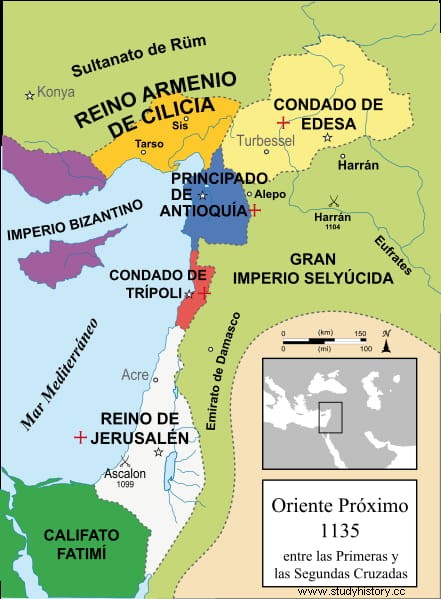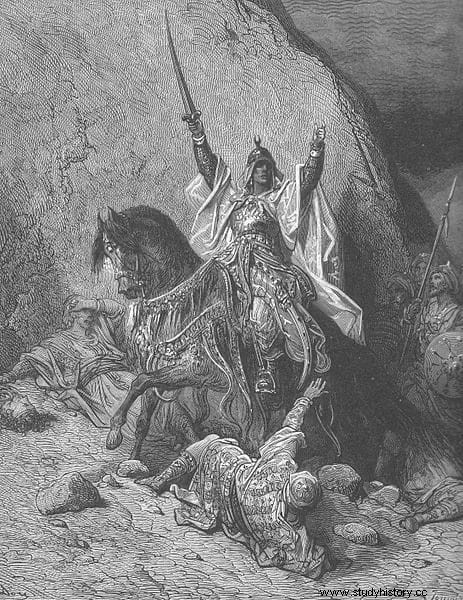Saladin has gone down in history as one of the great Islamic rulers and a brilliant soldier who conquered the Holy Land, managing to retain Jerusalem in the face of the Third Crusade's attempt to recapture the city. He was also a model of chivalry, admired by both Muslims and Christians. But he was human and, consequently, he also had critical moments. One of the worst was his unexpected defeat at the Battle of Montgisard by Baldwin IV, the Leper King .
Baldwin IV was born in 1161 in Jerusalem. He was the son of Amalric I, king of that city, and his wife, Agnes of Courtenay, countess of Jaffa and Ascalon, although she hardly saw her because her parents had to divorce so that the father could access the throne, a requirement of the nobility due to their degree of consanguinity. Baldwin was therefore raised by a historian - later a bishop - named William of Tyre. It was he who discovered that the boy suffered from leprosy when he observed that playing war with his friends he did not feel pain from the blows. That's why he would later have to cover his face in public with a mask.

For that disease there was no cure, so it was expected that he would not live long and he began to think about alternatives for the succession. However, Amalric died of dysentery during the siege of Banias in 1174 and Baldwin was proclaimed king at the age of thirteen (the age of majority then). And it is that the kingdom could not be without a visible head because it was going through moments of trouble. To the north, the Byzantine Empire had established the principality of Antioch, reducing the domain of Jerusalem. To the south, both the Second Crusade and Amalric himself had failed in their respective attempts to conquer the Egypt of the Fatimids, having to settle for making it tributary.
But there were also internal difficulties. Upon his return from the Egyptian campaign, the king married Maria Komnenos, great-granddaughter of Emperor Manuel I. This allowed Acre to return to royal hands and Amalric to agree to an alliance with the Byzantines to take Egypt together with the support of the Hospitaller Order. The uncoordinated plan went awry and they had to content themselves with renewing the tributes to the Fatimids. When Baldwin IV took over from his father, he was forced to allow the marriage of his stepmother, the aforementioned Maria Komnenos, to Balian of Ibelin, a noble crusader whose ambition seemed to be to connect with the royal family and impose his lineage on the offspring. .
This is how things were when in 1169 an unexpected character appears. He was called Al-Nāsir Ṣalāḥ ad-Dīn Yūsuf ibn Ayyūb, but he is better known as Saladin. A native of Tikrit (Iraq), where he was born in 1138, into a Kurdish family with a great military tradition, he had been growing and gaining experience under the orders of his uncle Shirkuh, general of Governor Nur al-Din. This is how he participated in the war against Amalric in Egypt, the first step towards an invasion in 1168 that ended in victory; Shirkuh was appointed vizier and chose his nephew as his assistant, who replaced him when the other died the following year. Success transformed Saladin, who abandoned his worldly ways and became very religious.
In Egypt, his power increased, even rivaling that of the caliph, although without actually confronting him. Instead, he felt strong enough to attack the Kingdom of Jerusalem in 1170. It was a quick and brief campaign, almost like a large-scale raid, after which he returned to Cairo and, taking advantage of the fact that the Fatimid caliph had just died Sultan was proclaimed. He then began an expansion in various directions:Libya, Yemen... The death of Nur al-Din left him free to take Damascus, where he settled in 1174, and then advanced towards Aleppo, becoming sultan of all Syria.
He did not lack internal enemies, especially the Zangui dynasty (Syrian vassal of the Seljuks), and he was even wounded in an attack that led him to fight the famous hashasin . But in 1177 his sights were higher. Since the crusaders had marched north to besiege Harem, which was in Syrian territory, Saladin considered the truce he had with them broken and began a campaign for Palestine that was unstoppable because there were hardly any troops to confront him. That allowed him to stand before the gates of Jerusalem. Baldwin, aware of his progress in that direction, gathered as many knights as he could and evacuated the city, taking with him the relic of the True Cross.
Confident in his overwhelming numerical superiority, Saladin not only did nothing to hinder this retreat, allowing his opponent to take refuge in Ashkelon (a city located 73 kilometers away), but also diverted part of his troops to besiege Gaza while he he moved north with the bulk of the army, entrusting the mission of attacking the king to another contingent. It would not take him long to verify that he had made a serious tactical error, but for the moment, he certainly did not seem to need much more to prevail, since Baldwin did not manage to gather more than 375 knights, to which an indeterminate number of infantrymen and turcipolos would have to be added. (Byzantine mounted archers), calculated between four and six thousand; it is not clear because of the divergence between sources.

Little thing a priori to confront the Muslims, who numbered between 21,000 and 26,000 if we make an average between the different figures outlined in documents. Now, all the Christian knights were veterans and that is why their value in combat multiplied. Among them were the aforementioned Balian of Ibelin and his elder brother Baldwin, Reynald of Sidon and Aubert (count of Sidon), Joscelin of Edessa (prince of Galilee), and Reynald I of Châtillon (prince of Antioch, who fiercely hated Saladin after having spent time in captivity in Aleppo). They were joined by 84 Templars led by their Grand Master, Eudes de Saint-Amand, who paradoxically had been an enemy of Amalric I.
Baldwin IV, aware of how limited his forces were, decided to risk taking the initiative and went in pursuit of Saladin, who, after attacking several cities in what is now central Israel, allowed his troops to scatter in search of food. Just at that moment, the Christian column arrived at their rear without the body left to defeat them being able to fulfill their mission. Thus, followed by Baldwin's troops, Saladin was overtaken near Ramallah, at a place called Mons Gisard. Today its exact location is not known; only that the Muslim baggage train was fording a river, stuck on banks that had become a quagmire because they were normally farmland.
Balduino could not have arrived at a better time, not only because the enemy was bogged down in that operation, but also because his horses were exhausted, after spending all day touring the area to gather supplies. In addition, the appearance of the Christians was totally unexpected, spreading panic among the Muslims, while the others hoisted the True Cross and prepared to charge. So incensed were they that it did not even matter that the king, weakened by his illness, fell from his mount and had to be helped to his feet, because afterwards he himself said a prayer before his men and was acclaimed. Q>
And then yes, the knights spurred their horses and rode lance at the ready against the Muslim lines, who had been taken by surprise and had not had time to adopt a proper defensive formation. The riders slashed through them like a knife, slaughtering left and right, unstoppable. Only Saladin's nephew, Taqi ad-Din desperately tried to buy time by rushing into the fray so that his uncle could organize the Mamluk guard, but they could only hold off the enemy for a while, as they were the only corps holding the type.
The Christian charge was so dizzying that Saladin himself had to give up any resistance to lighten his weight by shedding his chain mail, getting on a camel (racing, witnesses point out) and escaping in a hurry; all the Mamelukes gave their lives to protect the lord's escape from him, who finally made it to safety at Caunetum Esturnellorum and then returned to Egypt with heavy losses. It was November 25, 1177 and Baldwin IV thus obtained glory, since he himself led the attack with his hands bandaged to cushion the pain of his wounds and to be able to hold his sword.
After the brilliant victory, he returned to Ashkelon in the midst of torrential rains that lasted ten days, something that made the march of the defeated Islamic army (which was harassed on its way by the Bedouins) more painful; army if it could still be called that, since according to some authors it lost up to ninety percent of its troops. Christian casualties were also not few, calculated around a thousand dead and 750 wounded. For his part, the king then returned to his capital to cheers and congratulations. That date was instituted as a holiday and a Benedictine monastery was founded on the same battlefield, ensuring the survival of the Kingdom of Jerusalem.
At least it was like that for a short time, the time it took for leprosy to take the monarch's life, something that happened eight years later. As for Saladin, he reorganized his forces and had the opportunity to amply recover his military prestige with victories such as the Ford of Jacob, the Horns of Hattin or the conquest of Mesopotamia, until he finally took Jerusalem and stopped the Third Crusade . But that's another story.
